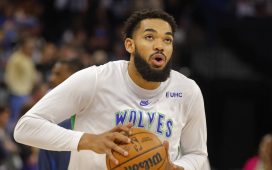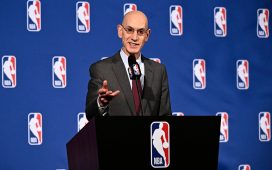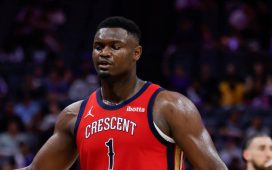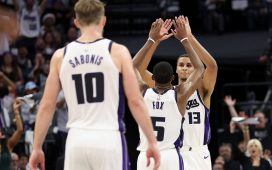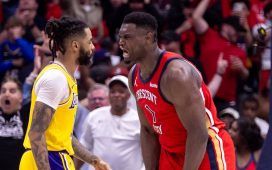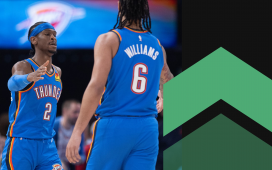In the 2020-21 NBA season, measurements in general are less trustworthy than ever before. Seemingly every night of the season, there are reports and triumphant graphics about how any number of players has accomplished something historic, unprecedented. This is partly because sports media has learned how to use its ever-expanding data metrics to always reshape context and make it seem that something unmissable is going on. That’s been going on for years, but this season, the history is also really happening. Many of the numbers are meaningful, at least in raw form.
Why so much new ground is being broken is not a complicated wonder. The league is experiencing an insane season, with compressed schedules and a lack of prep time leading to lesser defense, more load management and plenty of opportunity for scoring ballast. Inevitably, someone was always going to be consistently excellent in this landscape, and as such that excellence would be warped, inflated beyond merit if compared too readily to the occurrences of previous seasons. This, to get to the point, is why I keep seeing people compare the recent iteration of the Utah Jazz to the 2014-15 NBA champion, dynasty-making Golden State Warriors.
Because comparative thinking is a fool’s errand in normal times and a degenerate’s depraved pathology in current ones, we won’t dig any further into that specific case. Such things are for the therapist’s chair. The Jazz, on their own, are indeed an excellent team, worth their own consideration. Their year-to-year defensive brawn has come as no surprise, while their prodigious offense certainly has. A sort of logical advancement of modern trends and rule changes, the Jazz often play a four-out, maximum-spacing system, weaponizing the gravity and creativity of Donovan Mitchell, Mike Conley, Jr., Bojan Bogdanovic and the ascendant Jordan Clarkson beyond the three-point arc. Joe Ingles and Royce O’Neale also live out there in a more yeoman fashion, but both are still a threat to shoot—all of them are. Between the six of them, they’re averaging 40 three-pointers per game, with the team averaging close to 40 percent from three.
This is fun to watch! Most of these players are exciting isolation players and passers who make the ball bounce from zone to zone enjoyably, and they can also all pose a threat as pick-and-roll partners with Rudy Gobert within the arc. They all function as distinct satellites of viewing joy when the team is humming, which seems to be every game this year. Their system is reliable and, save for a few instances of especially inspired passing, as predictable as the math it tends toward; three is, of course, more than two. Generally speaking, the Jazz are going to win. Even more generally speaking, safe money lies with teams that play above-average defense while also maximizing three-point volume and efficiency in the regular season going forward. No night-to-night winning concept is better throughout the dog days of the season.
When the Jazz do lose, though—again, this is rare—it does appear to be about more than a random and unlikely-to-repeat blip of shooting accuracy variance. In other words, they have hibernating flaws, unusually inconspicuous because of the unique shape of the land they’re currently dominating in. The kinds of things it takes to beat them are what teams are doing less and less of in this hyper-strained season, but they’re not exactly rare basketball activities. When the Miami Heat simply badly out-rebounded them as they recently did in victory over the Jazz, for example, it does leave one realizing that Utah can probably not continue to get away with playing the 6-4 O’Neale at power forward in the more physical postseason and still expect to get as many shots as their opponent.
The Los Angeles Clippers, too, recently called the Jazz on their night-in-night-out size gamble and won the bet, but they did it an arguably more modernist way than what Utah’s max-spacing approach represents. The Clippers beat the Jazz without even seeing heavy minutes from a traditional center. This was obviously just one game, but it does underline what was more prominently visible in a bad loss to the Denver Nuggets, in which Nikola Jokic abused the Jazz on his way to a 47-point performance that stands tall in his MVP campaign resume. The Jazz and, more specifically, Gobert don’t fare well against elite size. Gobert is clearly top of the sport when it comes to preventing guards from scoring at the rim, but at stopping centers and bigger forwards (like those of the Clippers) in the restricted area, he is noticeably prone to being pushed around.
Backup center Derrick Favors has helped the Jazz play with more size and force in bursts when needed, but it’s obvious that their formula for winning goes hard on smaller lineups and three-point flame fests. After the All-Star break, it will be interesting to see if Utah mixes up its looks, perhaps eschewing the winning streaks of today to develop more playoff-friendly lineups and actions for tomorrow. There may be personnel limits preventing the full possibilities of such a project, and I may be wrong to believe that the Jazz actually need to do this. They are first in the league both by the record and by point differential, and their leads in both columns are both big and growing. Their losses, though consistent in nature and foreboding in the eyes of old heads, are just not very frequent and may be more vestigial in character than representative of an unavoidable basketball truth. If they can prove this much come summertime, you’re free to compare them to whomever you want.
